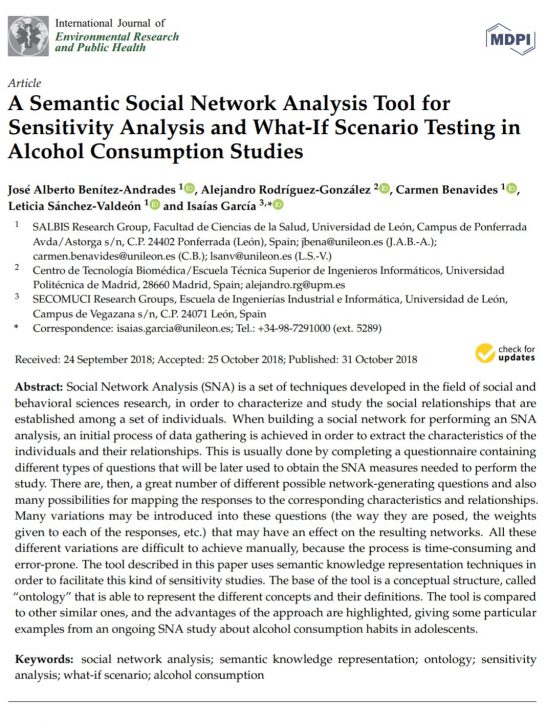Int. J. Environ. Res. Public Health 2018, 15(11), 2420; https://doi.org/10.3390/ijerph15112420
A Semantic Social Network Analysis Tool for Sensitivity Analysis and What-If Scenario Testing in Alcohol Consumption Studies
1SALBIS Research Group, Facultad de Ciencias de la Salud, Universidad de León, Campus de Ponferrada Avda/Astorga s/n, C.P. 24402 Ponferrada (León), Spain
2Centro de Tecnología Biomédica/Escuela Técnica Superior de Ingenieros Informáticos, Universidad Politécnica de Madrid, 28660 Madrid, Spain
3SECOMUCI Research Groups, Escuela de Ingenierías Industrial e Informática, Universidad de León, Campus de Vegazana s/n, C.P. 24071 León, Spain*
Author to whom correspondence should be addressed.
Int. J. Environ. Res. Public Health 2018, 15(11), 2420; https://doi.org/10.3390/ijerph15112420
Received: 24 September 2018 / Revised: 22 October 2018 / Accepted: 25 October 2018 / Published: 31 October 2018
(This article belongs to the Special Issue Social Networks and Health)
Abstract
Social Network Analysis (SNA) is a set of techniques developed in the field of social and behavioral sciences research, in order to characterize and study the social relationships that are established among a set of individuals. When building a social network for performing an SNA analysis, an initial process of data gathering is achieved in order to extract the characteristics of the individuals and their relationships. This is usually done by completing a questionnaire containing different types of questions that will be later used to obtain the SNA measures needed to perform the study. There are, then, a great number of different possible network-generating questions and also many possibilities for mapping the responses to the corresponding characteristics and relationships. Many variations may be introduced into these questions (the way they are posed, the weights given to each of the responses, etc.) that may have an effect on the resulting networks. All these different variations are difficult to achieve manually, because the process is time-consuming and error-prone. The tool described in this paper uses semantic knowledge representation techniques in order to facilitate this kind of sensitivity studies. The base of the tool is a conceptual structure, called “ontology” that is able to represent the different concepts and their definitions. The tool is compared to other similar ones, and the advantages of the approach are highlighted, giving some particular examples from an ongoing SNA study about alcohol consumption habits in adolescents. View Full-Text

